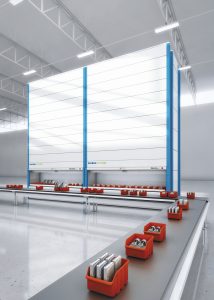You’re ready to make an investment in an automated storage and retrieval system to hold and dispense your inventory but you don’t know where to start. As Stephen Covey wrote “Begin with the end in mind”. Start by determining what you want the solution to do for your company. What problems do you need to resolve? Here are a few popular ones:
resolve? Here are a few popular ones:
- the need to reclaim valuable space for more revenue-producing activities
- reducing labor requirements to maintain the inventory and fulfill orders
- increasing accuracy
- improving safety
Writing an ASRS specification is a great start and it doesn’t have to be fancy, formal, or intimidating. For collaborative success, create a project team with representatives from the affected departments. It’s important to consider the mindset of the teams that are involved in the process and impacted by the results.
Finance will require an appropriate and measurable ROI in a timely manner. IT will want a straightforward interface that communicates well with other systems and reliably captures and reports the data that other departments need. Operations will demand that the fulfillment process is smooth, timelines and quality targets are met, and labor requirements are as projected. Users will want an ergonomic, user-friendly process that can be performed within their capabilities and a system that minimizes the risk of mistakes. Maintenance will want equipment that is trouble-free with minimal downtime, and reliable service support that is prompt and cost-effective.
Team up
For a project like this, consider partnering with a veteran in the industry that can provide a consultative role and unbiased solutions. A company like Abel Womack would be a good choice with their diverse product range and experienced engineering and sales teams. This consulting partner will need to know several things to pinpoint a solution that will meet your needs. Details will need to be shared regarding the inventory sizes, quantities, and weights as well as some ranking of speed of movement and fulfillment throughput requirements. The storage system must have the capacity to hold your current and future goods while matching your rate of picking and replenishing. Be sure to plan for seasonal fluctuations and growth. Expansion capability also should be considered.
would be a good choice with their diverse product range and experienced engineering and sales teams. This consulting partner will need to know several things to pinpoint a solution that will meet your needs. Details will need to be shared regarding the inventory sizes, quantities, and weights as well as some ranking of speed of movement and fulfillment throughput requirements. The storage system must have the capacity to hold your current and future goods while matching your rate of picking and replenishing. Be sure to plan for seasonal fluctuations and growth. Expansion capability also should be considered.
Down to details
In addition to the details of the inventory and the throughput rate, the specification for an automated storage and retrieval system (ASRS) can also include the following. Note that in some cases, these will begin as placeholders to prompt further definition as the project evolves.
- Space to be utilized
- Reclaimed space target
- Intended use and value of reclaimed space
- Timeline of when the system will be operational
- Budget
- Return on investment strategy
- Vendor and equipment vetting
- IT system interface plan
- Process definition (pick & pass, weigh-bag-tag, label printing, barcode-checking, order-batching, slotting, etc.)
- Reporting and tracking requirements
- Environment (ambient or controlled temperature, humidity, etc.)
- Inventory management requirements (order processing, FIFO control, expiration dates, serial numbers, cycle counting, etc.)
- Replenishment plan
- Accuracy targets (order picking and inventory control)
- Communication/Interface with other systems or equipment (ERP, WMS, conveyors, robots, etc.)
- Security clearances
- Operator training
- Labor target (how many pickers and picking hours will be required)
- Installation plan
- Service/maintenance requirements and contract
- Acceptance criteria
When it comes to setting a budget for the project, you might wonder how this can be done without knowing the costs of these ASRS systems. On the other hand, it’s difficult to get an accurate price without having a defined target of performance criteria to be met. To get the process started, ask the question, “what is it worth to the company to solve this problem?”. By answering this, you’ll be in a better position to create a budget and an ROI that can be justified.
hand, it’s difficult to get an accurate price without having a defined target of performance criteria to be met. To get the process started, ask the question, “what is it worth to the company to solve this problem?”. By answering this, you’ll be in a better position to create a budget and an ROI that can be justified.
Up close and personal
When you’ve found a solution that meets your needs, it can be beneficial to make a site visit to see how it works for others that have taken the same path. This will give you a chance to see the solution in action and ask about their experience. Experience is a valuable teacher and a less costly one for you when it’s someone else’s experience.
Having an ASRS specification in advance with defined targets will help to ensure a successful ASRS implementation. When you’re ready to get started, Abel Womack has the experience to help you navigate the process.



Leave a Reply
You must be logged in to post a comment.